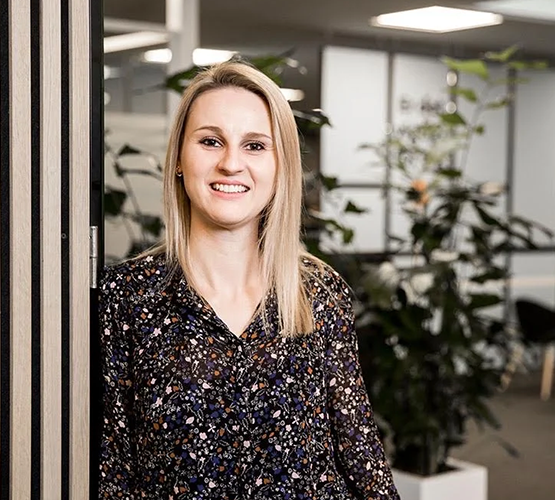Security and modern workplace in focus for JOAB
JOABNow boasting an efficient IT-environment, moving into the cloud was a strategic choice for Nordic's largest supplier of supplementary parts in the trucking industry.
Read MoreThe package distributor decided to solve data-related performance challenges by moving its entire IT environment to the cloud

Package distributor GLS Denmark is Denmark's highest rated package distributor with a Trustpilot rating from customers of 4.7 points. The company's headquarters are in Kolding, with separate locations in seven cities. GLS has approximately 1,100 employees and revenues of around DKK 2.4 billion. The company is a part of the GLS Group, which has a presence in 40 countries.
The company has recently been rebranded with a new message and is working to put itself in the place of the consumers in order to provide even better services. With the slogan "If it's important to you, it's important to us," GLS puts quality, service and transparency in the driver's seat.
Two and a half years ago, GLS made the decision to implement a cloud strategy. From then to now, the company has been on quite a journey: When they started off, they had no internal expertise in the field of cloud technology. Now the company has a fully operative cloud production environment, which has already delivered business value. Towards 2025, all legacy systems will have a new life in the cloud.
The motivation to migrate the IT environment to the cloud was, among other things, to solve performance challenges with a constantly growing business-specific data volume related to package data and scanning.
"The new way of using data started to strain our on-prem infrastructure. We also have a lot of peaks in our business area. It's hard to know how many packages that will arrive at us from day to day. Another major challenge was therefore to set up a solution to handle the volume fluctuations, without creating a monster scaled to manage the peaks," says Director IT & Commercial Services, Jana Hartwich of GLS Denmark.

According to Jana Hartwich, the greatest challenge initially was to see where they were going: Which order the tasks should have and which projects that were best suited for 'the new world.'
"We needed a kind of guide or roadmap to find out how we could get to where we wanted to be. There was a lot of trial and error to begin with," she says.
Hartwich adds that she believes the reason many companies have not taken the step into the cloud or are hesitant to make the decision, is lack of knowledge on how one really practically implements such a general project.
"Our employees definitely had such a need. The cloud sounds like a fantastic idea, but is it really as simple as everyone says? The first time you encounter a challenge that is extremely complex, with a thousand ways to resolve it, doubt rears its head. Is it really as simple as everyone says?"

Cooperation with Innofactor has been valuable in many way for GLS Denmark.
"We needed help to define our cloud journey in more detail, to give it all a bit more structure. We started with sparring around governance structures," Hartwich reminisces.
"Innofactor had experience and a Microsoft stamp that we ourselves didn't have at that point. So the relationship started off slowly with help for that journey, but ended up with us contacting Innofactor every time we came up against complex issues."
Hartwich emphasizes Innofactor's internal network as a great resource for GLS.
"We had a couple of contacts, who with their internal networks quickly enabled us to also establish contact with a number of other profiles. We discovered that this help was very effective – and we resolved our issues along the way," she says.
The work methodology has been to affiliate Innofactor's resources with GLS's projects. Sometimes as a technical lead, other times only for individual parts in a project.
"We work as a team, and Innofactor knows our overarching goals, where we're going and why."
GLS's first proper cloud project was a new app for the company's consumers for tracking packages.
Hartwich admits that they were somewhat brave: It was the very first cloud project, and on top of everything a MVP solution of the app was launched two days before Black Friday in 2021.
"We were excited to see if it would work, but knew at the same time that if the app was to succeed quickly, we'd have to launch it at a time where all consumers were conscious of the subject."
The immediate result was an extremely high number of app downloads, and it has kept its place on the App Store's hit list. Hartwich says that were also interested in finding out how the app worked after 200,000 downloads when adding extra capacity.
"We automated this, and actively followed it in our cloud environment to see if it worked, and it did. Now we have 750,000 users of the app in Denmark, so it is definitely a success."
Migrating the IT environment to the cloud provides valuable opportunities for scaling.
"We could have built the app before going to the cloud, but it wouldn't have been possible to scale it like we have. If we'd built it on-prem, we would have been finished at around 200,000 users."
Before the cloud journey, GLS had no internal expertise on cloud technology. Hartwich says they had the traditional division with development and operations as silos.
"The whole cloud journey has forced us to collaborate. Because you don't succeed alone – you have to be a part of a team. The cloud journey has made us realise this. At the same time it was new to everyone and thus a common starting point to create something together. Establishing DevOps has given us a whole new way of thinking and collaborating."
Initially, the new cloud strategy was received with mixed feelings.
"There was some scepticism to begin with, and there have been things that haven't quite worked as they should. But the organization has been ready for realignment. At the same time, we have said it loud and clear: People need to be prepared to learn something new every day, because Microsoft launches new solutions all the time."

C-level commitment has been critical for implementing a cloud strategy.
"I'm a part of the management. If I hadn't been, the project would have been impossible to implement, because you have to set aside time and you have to say 'no' to old on-prem projects."
"Like many others, we have a long list of old things that need fixing, and I've been saying 'no' to that for almost two years. That doesn't make you very popular on the business side. But I know and am convinced that this is the right thing to do, something our first projects also prove."

On its cloud journey going forward, GLS will focus far more on its customers.
"Our customers are both recipients and senders of packages. Going forward, we will look at what more we can do for the customers on the package journey. At the same time we have a lot of legacy, old operations-related things that need optimization. Our continued cloud journey will be a balance between new development and moving all of these old systems," Hartwich says.
The greatest challenge where GLS now stands is time, according to the proactive director.
"We know very well what needs to be done. We currently have a consultant from Innofactor here who will help us 'beat our SQL monster to death' – that is to say divide the database into smaller parts and move to the cloud. We will not just move our old on-prem database over to the cloud because it doesn't improve data, business logic or the applications. It becomes more scalable, but also very costly."
"Our strategy is to break down our on-prem solution as far as possible into smaller parts towards 2025. Our main challenge is how quickly we can achieve this," Hartwich says.
GLS's goal is to go 'all in' in the cloud. Hartwich says that there may be a few things the company can't move, but that will be very limited.
"We have a general Microsoft strategy. We have just implemented Microsoft CRM, we will proceed with Business Central, we have Power BI, etc. The plan also includes going to the cloud with everything we can on the client side."
"It makes sense to move as much as possible. For example, when we use Power BI, our entire data warehouse will be moved to the cloud due to performance. What we keep on-prem will be very limited," Hartwich maintains.
The benefits of the cloud journey have already materialised. Hartwich mentions automation of monitoring and performance as a comprehensive topic. GLS hasn't yet seen much of time to market, but that's in the pipeline going forward.
"We have built a lot of 'infrastructure as code,' which can be reused in the cloud. That's a huge advantage when we're moving as much as we are."
"The next thing we will look at is our machine learning. We have had major challenges with the fact that all of the algorithms we would like to run require a huge amount of on-prem capacity. To solve that, we can build smart solutions in the cloud that work far better. It's a huge benefit that we can work faster and easier with such data projects going forward."
Hartwich also highlights IT security.
"We have worked a lot with this in the past year. The security challenge is much easier for us to handle when we run as much Microsoft as possible, and can follow their standard and best practice."
"No matter what we came up against in our cloud journey, we knew that someone in Innofactor could help us along. They have been like a good friend we could call if we suddenly got stuck," Hartwich with GLS Denmark concludes.
Innofactor provided the following solutions and services for GLS:
"No matter what we came up against in our cloud journey, we knew that someone in Innofactor could help us along. They have been like a good friend we could call if we suddenly got stuck."
Jana Hartwich
Director IT & Commercial Services
GLS Denmark